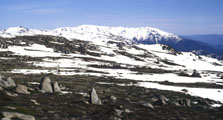|
 1 1
 2 2
|
|
The Snowy Mountains of Australia are the main range of the Australian Alps (around Mt. Kosciusko on the map). The Australian Alps extend for over 600 km through Victoria and New South Wales and are themselves a part of the great Dividing range, a vast chain of high elevation areas that extend along the east coast of Australia from Tasmania to Cape York.
First formation of the Australian Alps began already 600 million years ago. The slow lifting of ancient rocks that formed the present mountains occurred in the last 50 - 60 million years. The old age of the underlying sediments leads to a peculiarity of the Australian Alps: the presence of soil over all the landscape including on steep slopes and rolling summits. Although glaciation was not extensive in the Australian Alps, glacial and periglacial processes during the Ice Ages made a major contribution to the present appearance.
The alpine zone in the Snowy Mountains is characterised by high precipitation in the range of 1800-3100 mm per year. Temperatures for July and January are 10 °C and -4 °C respectively.
|

 3
3
 4
4
 5
5
 6
6
 7
7
 8
8
 9
9
 10
10
 11
11
 12
12

